(G6)Unit3电子教案
人教版六年级英语上册第三单元备课教案
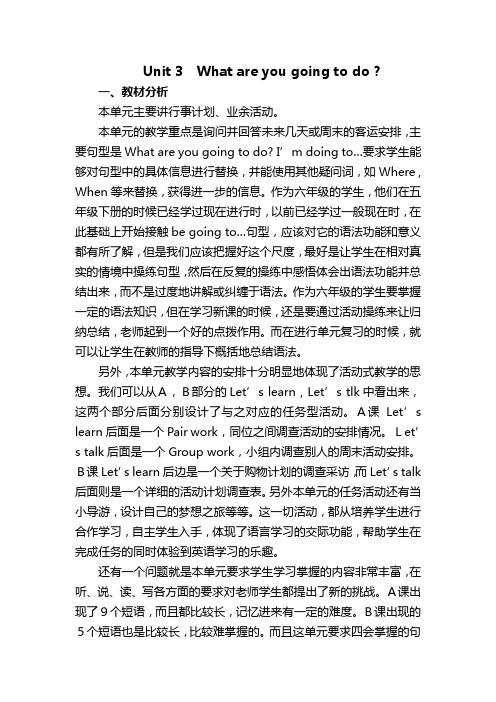
Unit 3 What are you going to do ?一、教材分析本单元主要讲行事计划、业余活动。
本单元的教学重点是询问并回答未来几天或周末的客运安排,主要句型是What are you going to do? I’m doing to…要求学生能够对句型中的具体信息进行替换,并能使用其他疑问词,如Where , When等来替换,获得进一步的信息。
作为六年级的学生,他们在五年级下册的时候已经学过现在进行时,以前已经学过一般现在时,在此基础上开始接触be going to…句型,应该对它的语法功能和意义都有所了解,但是我们应该把握好这个尺度,最好是让学生在相对真实的情境中操练句型,然后在反复的操练中感悟体会出语法功能并总结出来,而不是过度地讲解或纠缠于语法。
作为六年级的学生要掌握一定的语法知识,但在学习新课的时候,还是要通过活动操练来让归纳总结,老师起到一个好的点拨作用。
而在进行单元复习的时候,就可以让学生在教师的指导下概括地总结语法。
另外,本单元教学内容的安排十分明显地体现了活动式教学的思想。
我们可以从A,B部分的Let’s learn , Let’s tlk中看出来,这两个部分后面分别设计了与之对应的任务型活动。
A课Let’s learn后面是一个Pair work,同位之间调查活动的安排情况。
Let’s talk后面是一个Group work,小组内调查别人的周末活动安排。
B课Let’s learn后边是一个关于购物计划的调查采访,而Let’s talk 后面则是一个详细的活动计划调查表。
另外本单元的任务活动还有当小导游,设计自己的梦想之旅等等。
这一切活动,都从培养学生进行合作学习,自主学生入手,体现了语言学习的交际功能,帮助学生在完成任务的同时体验到英语学习的乐趣。
还有一个问题就是本单元要求学生学习掌握的内容非常丰富,在听、说、读、写各方面的要求对老师学生都提出了新的挑战。
六年级上册英语教案Unit3 My weekend plan

3)困难、障碍(重难点)及突破措施:
通过与他人交流讨论,学会运用Where are you going? To the bookstore ….句型询问并回答他人。
4)个性差异:
多数学生能根据拼读规律全部认读拼写所有词汇。
2、语言技能:
1)听:学生能听懂本课单词、句型、课文。
2)说:学生会用重点句型:Where are you going? To the bookstore ….句型询问并回答他人。
3)读:学生能认读本课生词及句型、并能用正确的语音语调朗读课文。
4)写:学生能正确抄写单词句子。
5)玩演视听:全体学生能主动参与角色扮演,根据教师指令做游戏或动作。
本课:1)Where are you going? To the bookstore….2)Can I help you? Yes,….句型询问并回答他人。
3.在具体的语境中理解简单的语法项目的意义及用法。
1)Where are you going? To the bookstore….2)Can I help you? Yes,….句型询问并回答他人。
学情分析
1.知识经验:
1)已学:
语音:学生已经接触过部分单词new,已学单词,book,bookstroe.
词汇:some word book
语法:全体学生已学What are you going to do?...结构。
2)未学:
词汇:dictionary, comic book, word book, postcard .(自学能会:word book, postcard,合作能会:comic book,,需要教师点拨:dictionary)
人教PEP版英语六年级上册Unit 6教案第3课时
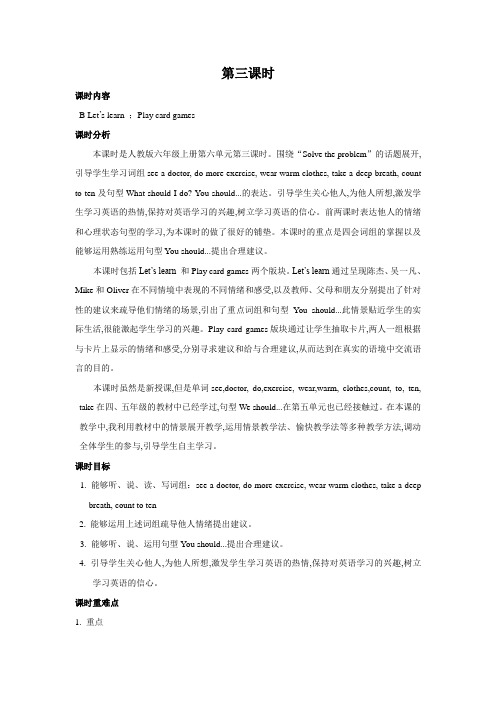
第三课时课时内容B Let’s learn ;Play card games课时分析本课时是人教版六年级上册第六单元第三课时。
围绕“Solve the problem”的话题展开,引导学生学习词组see a doctor, do more exercise, wear warm clothes, take a deep breath, count to ten及句型What should I do? You should...的表达。
引导学生关心他人,为他人所想,激发学生学习英语的热情,保持对英语学习的兴趣,树立学习英语的信心。
前两课时表达他人的情绪和心理状态句型的学习,为本课时的做了很好的铺垫。
本课时的重点是四会词组的掌握以及能够运用熟练运用句型You should...提出合理建议。
本课时包括Let’s learn 和Play card games两个版块。
Let’s learn通过呈现陈杰、吴一凡、Mike和Oliver在不同情境中表现的不同情绪和感受,以及教师、父母和朋友分别提出了针对性的建议来疏导他们情绪的场景,引出了重点词组和句型You should...此情景贴近学生的实际生活,很能激起学生学习的兴趣。
Play card games版块通过让学生抽取卡片,两人一组根据与卡片上显示的情绪和感受,分别寻求建议和给与合理建议,从而达到在真实的语境中交流语言的目的。
本课时虽然是新授课,但是单词see,doctor, do,exercise, wear,warm, clothes,count, to, ten, take在四、五年级的教材中已经学过,句型We should...在第五单元也已经接触过。
在本课的教学中,我利用教材中的情景展开教学,运用情景教学法、愉快教学法等多种教学方法,调动全体学生的参与,引导学生自主学习。
课时目标1. 能够听、说、读、写词组:see a doctor, do more exercise, wear warm clothes, take a deepbreath, count to ten2. 能够运用上述词组疏导他人情绪提出建议。
选修六unit3全单元教案
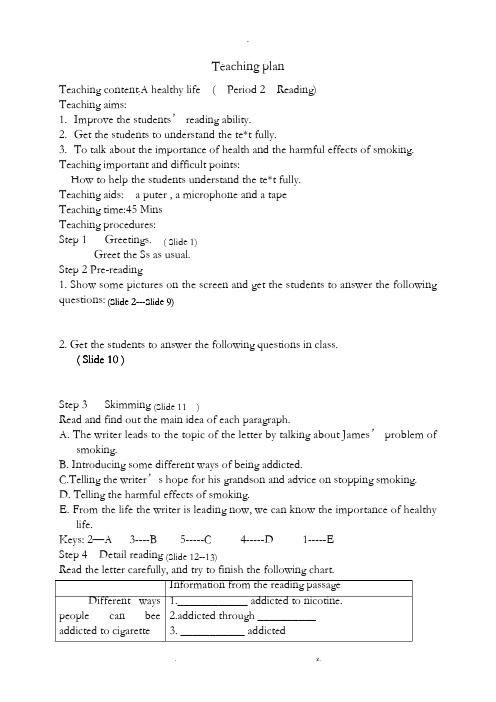
Teaching planTeaching content:A healthy life ( Period 2 Reading)Teaching aims:1.Improve the students’ reading ability.2.Get the students to understand the te*t fully.3.To talk about the importance of health and the harmful effects of smoking. Teaching important and difficult points:How to help the students understand the te*t fully.Teaching aids: a puter , a microphone and a tapeTeaching time:45 MinsTeaching procedures:Step 1 Greetings. ( Slide 1)Greet the Ss as usual.Step 2 Pre-reading1. Show some pictures on the screen and get the students to answer the following questions: (Slide 2---Slide 9)2. Get the students to answer the following questions in class.( Slide 10 )Step 3 Skimming (Slide 11 )Read and find out the main idea of each paragraph.A. The writer leads to the topic of the letter by talking about James’ problem ofsmoking.B. Introducing some different ways of being addicted.C.Telling the writer’s hope for his grandson and advice on stopping smoking.D. Telling the harmful effects of smoking.E. From the life the writer is leading now, we can know the importance of healthylife.Keys: 2—A 3----B 5-----C 4-----D 1-----EStep 4 Detail reading (Slide 12--13)Read the letter carefully, and try to finish the following chart.Information from the reading passageDifferent ways people can bee addicted to cigarette 1.____________ addicted to nicotine.2.addicted through __________3. ___________ addictedHarmful physical effects for smokers 1.do terrible damage to .2.have difficulty in .3.can not _______________ .Effects that a person’s smoking can have on other people 1.other people _________________ .2. The cigarette smoke may do harm to __________________________Effects that smokingcan have on sportingperformancebe unable to ______________ .Suggested answers: physically, habits, mentally, heart and lungs , being pregnant , run fast, dislike the smell ,other people near the smoker ,enjoy sportStep 5 Reading, listening and summary1. Read the article and find out the suggestions James’ grandfather found on the Internet.(Slide 14)Suggested answers:1)Prepare yourself.2)Be determined.3)Break the habit.4)Rela*.5)Get help if you need it.6)Keep trying.2. Listen to the passage and fill in the blanks in the following summary.(Slide 15) Choose a day that is not __________ to quit smoking. Make a list of all the __________ you will get from stopping smoking. ___________ all your cigarettes at the end of the day before you plan to quit. ________ the list of benefits you wrote when you feel like smoking. Develop some other habits like walking, drinking some water, cleaning the house and so on to keep yourself busy. If you feel nervous or stressed, try to do some __________ e*ercises like deep breathing. You can stop smoking with a friend or join a group. If you feel really bad, ask a doctor or _________ for help. The most important thing is to keep trying. Don't feel ________ if you _________ because some people have to try many times before they finally quit smoking. Never give up and you will succeed.3. Check the students’ answers.Suggested answers:Stressful, benefits, throw away , Reread ,Rela*ation, chemist ,ashamed , weaken4. Get the students to read the passage together.Step 6 Discussion ( Slide 16)1. What kind of person dMake a short dialogue in pairs.Step 7 Homework ( Slide 17 )1. Discuss the questions after class.2. Find out the key points of the te*t.3. Search some more information about the harmful effects of smoking and adviceon stopping smoking.Step 8 Ending ( Slide 18)Module 6 Unit 3 A Healthy LifeUsing LanguageTeaching Aims:By the end of this lesson, students will be able to:*get to know more about HIV/AIDS*know how to protect themselves from AIDS*talk about AIDS and AIDS awarenessTeaching Important and Difficult Point:To show the students an appropriate attitude towards AIDS patientsTeaching Procedures:” sung by famous football players. Step One: Warming UpThe students are asked to watch a video clip and discuss what it is about.(The video clip is about the change of an AIDS infected woman in 90 days.)This part is designed to impress the students with the damage HIV/AIDS does to a person. Step Two: Pre-readingBackground Learning: Some information about AIDS.*red ribbon is an international symbol of AIDS awareness*it is worn by people around the World AIDS Day*it calls for care and concern on AIDS*the World AIDS Day: December 1stStep Three: While-readingTask 1: SkimmingChoose a main idea for each section* Section 1Background information about what HIV / AIDS.*Section 2Ways to protect yourself.*Section 3Some wrong statements about AIDSTask 2 Careful ReadingHIV is a virus, a very small living thing that causes disease.2. How does HIV harmHIV virus weakens a person’s immune system and eventually it damages the immune system somuch that the body can no longer fight against disease.No, it is incurable.Part Two: In order to stay safe, you _________.A. should not share needles with someone else.B. have to avoid using anything else that the person has used while injecting drugs.C. should use a condom if you have se* with another one.D. All of the above.*You can catch AIDS after drinking from the glass used by an HIV-infected person.*I can bee infected with HIV by swimming in a pool, holding hands or kissing someone with HIV.*People who have not injected drugs do not need to get tested for HIV.*If I had HIV, I would know because I would feel sick.*Kids can get AIDS by being bitten by mosquitoes or other insects.*Sharing food with someone infected with HIV will give you HIV, too.*It is very likely that you will die if you bee infected with HIV.*If you have HIV, you will always get AIDS eventually.prehending:”There are between 900,000 and 1,125,000 Americans infected with it.Some two million people died of it each year2. This passage is _____.A. an advertisementB. a posterC. a magazine coverD. a criticismStep Four: Post-reading Let’s say something about AIDS.1. Word Bank: The new words we have learned.do damage/harm to 伤害infect (v.感染) – infected (adj.被感染的) – infectious (adj.有传染性的)be infected with 被…感染stage (v.阶段) drug (n.毒品)inject (v.注射) injection (n.注射)red ribbon 红丝带 prejudice (n. 偏见)awareness (n.意识,觉悟) be aware of 意识到virus (n.病毒) immune system 免疫系统cure (v.治愈) – curable (adj.可治愈的) – incurable (adj.不可治愈的)2.E*ercise 1: Fill in the blanks with proper words.①艾滋病是一种可传染的无法医治的疾病。
外研版九年级英语上册教案 Module6 Unit3

1.Review the grammar focus we have learned in the M6.
2. Finish the poster after class.
3. FinishJiaoyuxue and keshitexun.
学生可以对所学知识进行巩固和运用。
Blackboard designing
After-class
reflections
3) My parents will be angry if ________________.
4) If it rains next Saturday, I_________________.
4. Complete the conversation with the correct form of the words and expressions in the box. (Activity 4)
1) If I start after dinner, I’ll finish it before I go to bed.
2) If you do all these other things instead of your homework, you won’t have time to study.
3) He thinks something will go wrong if I play games on it.
复习条件状语从句,掌握其用法。
Practice
1. Rewrite the sentences with if. (Activity 1)
1) Eat some breakfast, or you’ll get hungry at school.
Module6Unit3复习教案

1.理论介绍:首先,我们要复习太阳系的基本概念。太阳系是由太阳和围绕它运行的八大行星组成的。它在我们宇宙中的位置非常特殊,是地球上生命存在的关键因素。
2.案例分析:接下来,我们来看一个具体的案例,了解太阳系在实际中的应用,以及它如何帮助我们理解宇宙和地球的关系。
3.重点难点解析:在讲授过程中,我会特别强调一般现在时的句型结构和名词所有格的用法。通过例句和练习,帮助学生理解并掌握这些重点。
(五)总结回顾(用时5分钟)
今天的学习,我们复习了太阳系的基本概念、地球在太阳系中的位置以及一般现在时的语法点。通过实践活动和小组讨论,我们加深了对太阳系知识的理解。希望大家能够将这些知识点运用到日常生活中,并保持对宇宙探索的热情。如果有任何疑问或不明白的地方,请随时向我提问。
五ห้องสมุดไป่ตู้教学反思
在今天Module 6 Unit 3《The Earth and the Solar System》的复习课上,我发现学生们对太阳系的知识表现出浓厚的兴趣。通过这节课的教学,我有一些深刻的体会和反思。
三、教学难点与重点
1.教学重点
-词汇:重点掌握与宇宙、地球及太阳系相关的词汇,如planet, star, solar system, universe, galaxy, gravity等,并能在实际语境中正确运用。
-句型:熟练运用一般现在时的句型结构,如There is...,Can you see...?I can see...等,进行问答和描述。
四、教学流程
(一)导入新课(用时5分钟)
同学们,今天我们将要复习的是Module 6 Unit 3《The Earth and the Solar System》。在开始之前,我想先问大家一个问题:“你们是否想过,为什么地球上有生命存在,而其他行星却没有?”这个问题与我们将要复习的内容密切相关。通过这个问题,我希望能够引起大家的兴趣和好奇心,让我们一同探索太阳系和地球的奥秘。
人教版高中英语选修六《Unit3 A healthy life》教学设计
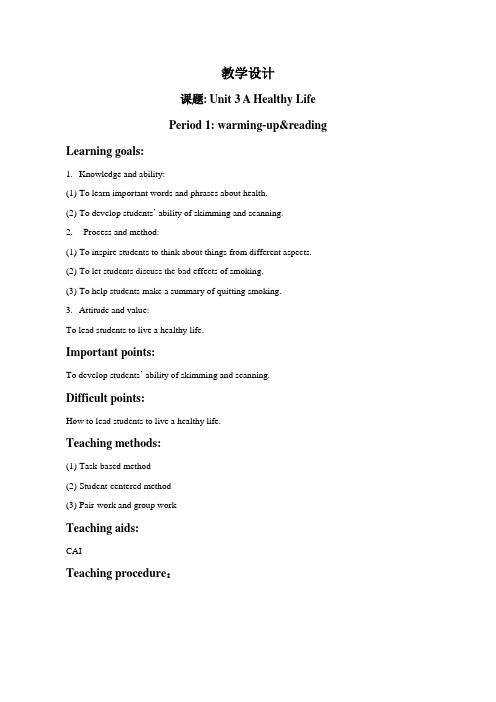
教学设计课题: Unit 3 A Healthy LifePeriod 1: warming-up&reading Learning goals:1.Knowledge and ability:(1)To learn important words and phrases about health.(2)To develop students’ ability of skimming and scanning.2.Process and method:(1)To inspire students to think about things from different aspects.(2)To let students discuss the bad effects of smoking.(3)To help students make a summary of quitting smoking.3.Attitude and value:To lead students to live a healthy life.Important points:To develop students’ ability of skimming and scanning.Difficult points:How to lead students to live a healthy life.Teaching methods:(1)Task-based method(2)Student-centered method(3)Pair-work and group workTeaching aids:CAITeaching procedure:different colors in the right order. 心。
引出下文的总结通过为每个段落选出正确的标题,深入了解戒烟的方式。
Step 4 Discussion (show time) 1.T gives the situation: suppose you are a teacher, howto persuade Xiaoming to stop smoking?2.Arrange Ss in groups to discuss it and make a smalldrama. In this process, T can present some usefulexpressions on the screen for Ss and T should join theSs one group by one group, listening and offering help.3.Ss show their small dramas.通过表演课堂小话剧的形式,让学生学会运用本堂课学到的戒烟建议,并培养学生表达个人观点、说服他人的能力。
Unit3教案6-PEP版小学英语六年级上册
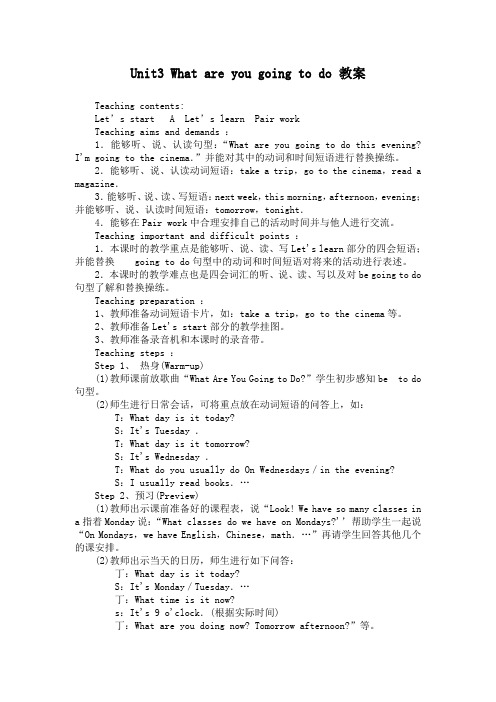
Unit3 What are you going to do 教案Teaching contents:Let’s start A Let’s learn Pair workTeaching aims and demands :1.能够听、说、认读句型:“What are you going to do this evening? I'm going to the cinema.”并能对其中的动词和时间短语进行替换操练。
2.能够听、说、认读动词短语:take a trip,go to the cinema,read a magazine.3.能够听、说、读、写短语:next week,this morning,afternoon,evening;并能够听、说、认读时间短语:tomorrow,tonight.4.能够在Pair work中合理安排自己的活动时间并与他人进行交流。
Teaching important and difficult points :1.本课时的教学重点是能够听、说、读、写Let's learn部分的四会短语;并能替换 going to do句型中的动词和时间短语对将来的活动进行表述。
2.本课时的教学难点也是四会词汇的听、说、读、写以及对be going to do 句型了解和替换操练。
Teaching preparation :1、教师准备动词短语卡片,如:take a trip,go to the cinema等。
2、教师准备Let's start部分的教学挂图。
3、教师准备录音机和本课时的录音带。
Teaching steps :Step 1、热身(Warm-up)(1)教师课前放歌曲“What Are You Going to Do?”学生初步感知be to do 句型。
(2)师生进行日常会话,可将重点放在动词短语的问答上,如:T:What day is it today?S:It's Tuesday .T:What day is it tomorrow?S:It's Wednesday .T:What do you usually do On Wednesdays/in the evening?S:I usually read books.…Step 2、预习(Preview)(1)教师出示课前准备好的课程表,说“Look! We have so many classes in a指着Monday说:“What classes do we have on Mondays?'’帮助学生一起说“On Mondays,we have English,Chinese,math.…”再请学生回答其他几个的课安排。
人教版六年级英语上册UNIT3教案
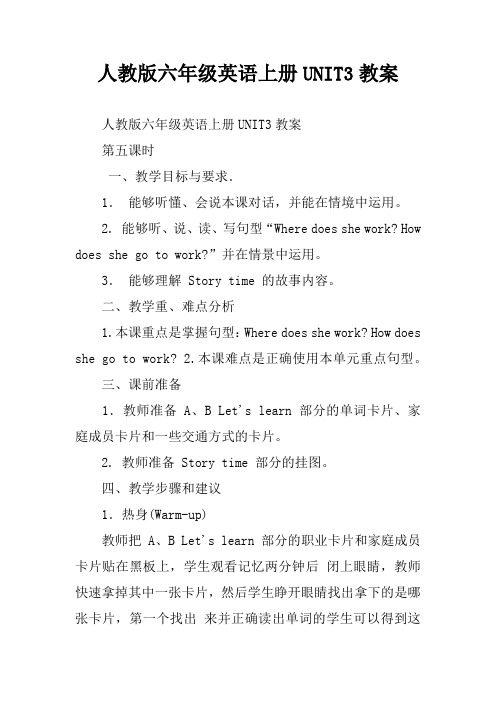
人教版六年级英语上册UNIT3教案人教版六年级英语上册UNIT3教案第五课时一、教学目标与要求.1.能够听懂、会说本课对话,并能在情境中运用。
2. 能够听、说、读、写句型“Where does she work? How does she go to work?”并在情景中运用。
3.能够理解 Story time 的故事内容。
二、教学重、难点分析1.本课重点是掌握句型:Where does she work? How does she go to work?2.本课难点是正确使用本单元重点句型。
三、课前准备1.教师准备 A、B Let's learn 部分的单词卡片、家庭成员卡片和一些交通方式的卡片。
2. 教师准备 Story time 部分的挂图。
四、教学步骤和建议1.热身(Warm-up)教师把 A、B Let's learn 部分的职业卡片和家庭成员卡片贴在黑板上,学生观看记忆两分钟后闭上眼睛,教师快速拿掉其中一张卡片,然后学生睁开眼睛找出拿下的是哪张卡片,第一个找出来并正确读出单词的学生可以得到这张卡片。
2.预习(Preview)(1)教师放第一单元歌曲“How Do You Go to School?'’的录音,学生跟唱。
在热身活动中得到卡片的学生开始把卡片传给后面的同学,依次传递,歌曲结束时,得到卡片的学生用卡片上的单词说一个句子,如:…is a…(2)Let's try 学生打开学生用书第 62 页,教师放录音,学生听音、勾出正确的选项。
录音内容如下:Girl:What does your mother do?Boy:She is an engineer.Girl:Where does she work?Boy:She works in a shoe company.Girl:How does she go to work?Boy:She goes to work by subway.3.新课呈现(Presentation) Let's talk(1)教师说:“I go to school by subway.”在黑板上板书:subway,学生跟说,然后教师启发学生说出其它的交通方式,教师把学生想到的交通方式依次写在 subway 的下面。
人教版六年级英语上册Unit3 单元教案3

Unit 3 My weekend plan 第一课时A Let’s learn & Make a plan一、教学目标与要求:1.能够听、说、读、写短语:visit my grandparents,see a film,take a trip,go to the supermarket.2. 掌握重点句子What are you going to do?I am going to ...进行简单的提问与回答关于计划的相关动作,并在真实场景中运用所学语言进行真实交流和运用。
3.在对话交流中使学生养成用英语交流的习惯,培养良好的语音,语调和语感。
二、教学重点、难点分析: 本课时的教学重点和难点是掌握四会短语和A Let's learn部分中进行简单的提问与回答关于计划的相关动作。
三、教学准备:多媒体课件。
单词图片四、教学步骤和建议:Step1.Preparation 1.Greeting 2.Let’s talk about our life.引用学过句型,操练交流。
Step2 Presentation (1)展示本部分的图片,向学生提出两个问题,并让学生回答。
Who are they?What are they talking about ?教师组织学生分为3-4人一个小组,尝试着猜想他们在讨论什么,从而引出本节课讨论的有关be going to表示将来时简单计划的话题。
单词呈现2)教师展示本节课的短语图片,引领学生学习这些重要的短语,并引导学生利用多种方法记忆短语visit my grandparents,see a film,take a trip,go to the supermarket。
听音正音3)听录音,指导学生完成探究学习1中的内容,并指导学生记忆关键词。
Pair work 4)展示重点句型,并加以操练What are you going to do?I’m going to 组织学生讲所学短语运用到语句中,进行交流练习。
Module6 Unit3 精品教案
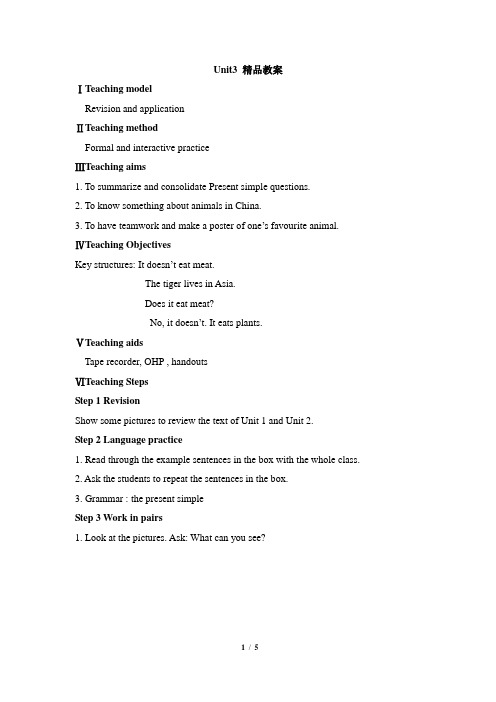
Unit3 精品教案ⅠTeaching modelRevision and applicationⅡTeaching methodFormal and interactive practiceⅢTeaching aims1. To summarize and consolidate Present simple questions.2. To know something about animals in China.3. To have teamwork and make a poster of one’s favourite animal.ⅣTeaching ObjectivesKey structures: It doesn’t eat meat.The tiger lives in Asia.Does it eat meat?No, it doesn’t. It eats plants.ⅤTeaching aidsTape recorder, OHP , handoutsⅥTeaching StepsStep 1 RevisionShow some pictures to review the text of Unit 1 and Unit 2.Step 2 Language practice1. Read through the example sentences in the box with the whole class.2. Ask the students to repeat the sentences in the box.3. Grammar : the present simpleStep 3 Work in pairs1. Look at the pictures. Ask: What can you see?2. Ask and answer with a partner.4. Call back the answers from the whole class, check the answers.Keys :1. —Does Meimei the elephant come from Yuannan, China ?—Yes, it does.2. —Does Kingba the tiger come America?—No, it doesn’t. It comes from Asia.Step 4 Complete the sentences with does or doesn’t.1. Read through the sentences with the whole class.2. Ask the students to complete the sentences with a partner.3. Call back the answers from the whole class, and check the answers.Step 5 Complete the passage with the correct form of the words in the brackets.1. Read through the passage with the whole class.2. Ask the students to fill in the blank individually, and then check with a partner.3. Call back the answers from the whole class, and check the answers.4. Read the passage together loudly.Step 6 Complete the word map with the words from the box.1. Read through the words in the box with the whole class.2. Ask the students to complete the word map with the words from the box with a partner.3. Call back the answers from the whole class, and check the answers.Step 7 Around the world:1. Ask the students to look at the picture and discuss what they can see.2. Read through the information with the whole class, and talk something about them. Step 8 Module task: Making a poster of your favourite animal.1. Work in groups.1) Find out about an animal.2) Talk about your favourite animal.3) Choose one animal to write about4) Find out about the animalIt’s big/ small / tall, black and white /…It comes from Asia / Africa /…It eats meat / grass/ bamboo/…2. Make a poster about your group’s animal.1) Draw it or find a photo.2) Write some information about it.3. Present your poster to the class.Step 9 Important and difficult points.行为动词一般现在时的疑问式和回答一般现在时的疑问式在句首加助动词do, 主语为第三人称单数时在句首加does,其结构是:1.Do + 主语+ 动词原形…?They live near our school.Do they live near our school?The students like learning English.Do the students like learning English?2.Does + 主语(第三人称单数)+ 动词原形…?He watches TV every evening.Does he watch TV every evening?My father teaches Chinese.Does your father teach Chinese?3.简略回答用助动词do / does 和don’t / doesn’t代替行为动词。
2020外研版(新标准)英语九年级上册Module6ProblemsUnit3教案
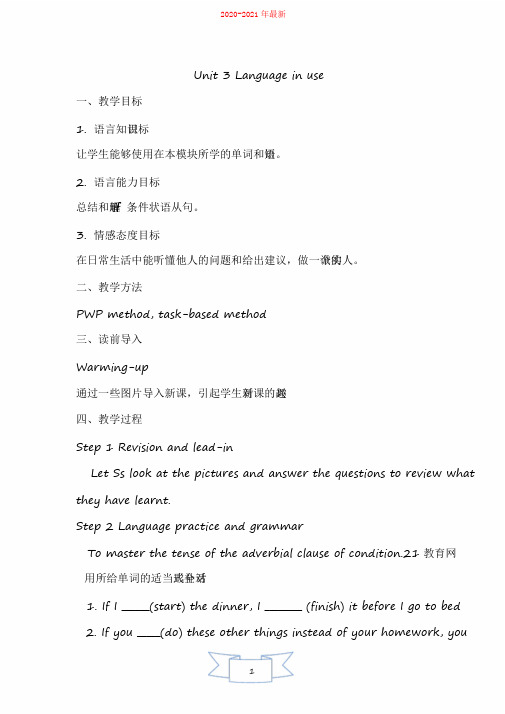
Unit 3 Language in use一、教学目标1. 语言知识目标语。
让学生能够使用在本模块所学的单词和短2. 语言能力目标解if 条件状语从句。
总结和理3. 情感态度目标的人。
诚实在日常生活中能听懂他人的问题和给出建议,做一个二、教学方法PWP method, task-based method三、读前导入Warming-up趣。
通过一些图片导入新课,引起学生对新课的兴四、教学过程Step 1 Revision and lead-inLet Ss look at the pictures and answer the questions to review what they have learnt.Step 2 Language practice and grammarTo master the tense of the adverbial clause of condition.21教育网话全对用所给单词的适当形式补1. If I ______(start) the dinner, I ________ (finish) it before I go to bed2. If you _____(do) these other things instead of your homework, you__________(not have) time to study.3. He thinks something _______(go) wrong if I play games on it. Grammar: If 从句(2)i f ,常见的if 条件状语从句一、引导条件状语从句最常用的连词是表示在某条件下,某事很可能发生。
e.g. If you ask him, he will help you.如果你请他帮忙,他会帮你的。
If he does not work hard, he will fail his exams.如果他不努力,考试就要不及格了。
6AUnit 3教案

Unit 3 It was there单元教学目标:1、能听懂、会说和会读单词和词组:a dairy, a CD Walkman, a roll of film,a pair of glasses, a mobile phone, earphones2、能听懂、会说、会读和会写句型:Where’s your …? It’s behind/under/on/in the … It isn’t there now. It was there a moment ago. Where are your …? They’re behind/under/on/in the …the … They aren’t there now. They were there a moment ago.3、能熟练地在情景中熟练的运用本单元所学的句型和日常交际用语。
1、4、了解字母组合ear 和ere在单词中的发音。
单元教材分析:本单元设置了a running race这一场景,通过SuYang和SuHai 想要拍照,却找不到相机与胶卷,而后四处寻找的过程,展示了Where’s the camera? It’s in your bag. It isn’t there now. It was there a moment ago. Where are the films? They’re in your bag. They aren’t there now. They were there just now.这样一组句型,引出了小学阶段的第三个时态:一般过去时。
本单元将重点学习过去时的两个时间状语:a moment ago 和just now,以及be动词的过去式was和were。
单元学情分析:本单元学习一般过去时,这是一种新的时态,在以前学生学过一般现在时和现在进行时,所以在学这个时态的时候教师应该从学过的2种时态入手,这样学生就能够自然而然的进入新知的学习。
六年级上册英语教案-Unit3Lesson14Snow!It’sWinter!冀教版三起

教案:六年级上册英语教案Unit 3 Lesson 14 Snow! It’sWinter!一、教学目标1. 知识目标(1)能够听懂、会说、会读本课的生词和重点句子。
(2)能够运用所学知识描述冬天的天气和活动。
2. 能力目标(1)能够正确使用一般现在时描述天气和季节。
(2)能够通过图片和情景,运用所学知识进行简单的交流和讨论。
3. 情感目标培养学生的环保意识和团队合作精神,激发学生学习英语的兴趣。
二、教学内容本课主要介绍冬天的天气和活动,让学生学会用英语描述季节和天气。
重点句型为:What’s the weather like? It’s以及 Canyou ?Yes, I can. / No, I can’t.三、教学重点与难点1. 重点:能够听懂、会说、会读本课的生词和重点句子,能够运用所学知识描述冬天的天气和活动。
2. 难点:一般现在时的运用,以及如何正确使用情态动词can。
四、教具与学具准备1. 教具:PPT、图片、单词卡片、录音机、磁带。
2. 学具:课本、练习册、单词卡片、录音机、磁带。
五、教学过程1. 热身(5分钟)(1)播放上一课的录音,让学生跟读。
(2)老师出示一些与冬天有关的图片,引导学生用中文描述。
2. 导入(5分钟)(1)老师出示一幅冬天的画面,引导学生用英语描述。
(2)引入本课的主题:Snow! It’s Winter!3. 课堂展示(15分钟)(1)老师出示单词卡片,引导学生学习本课的生词。
(2)老师带领学生学习本课的重点句型:What’s the weather like? It’s以及 Can you ?Yes, I can. / No, I can’t.(3)进行角色扮演,让学生运用所学知识进行情景对话。
4. 练习与巩固(10分钟)(1)完成课本P57的练习题。
(2)老师出示一些与冬天有关的图片,引导学生用英语描述。
(2)引导学生思考:如何保护环境,减少污染。
六、板书设计板书设计如下:Snow! It’s Winter!What’s the weather like?It’sCan you ?Yes, I can.No, I can’t.七、作业设计1. 抄写本课生词和重点句子。
六年级上册英语Unit3教案(冀教版)
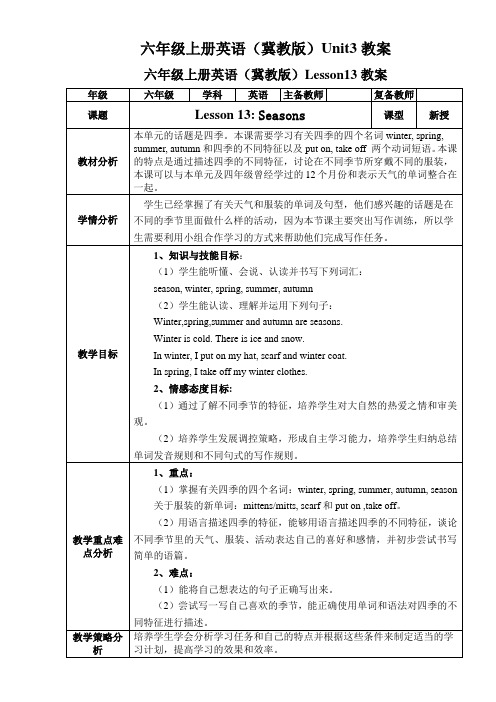
六年级上册英语(冀教版)Unit3教案六年级上册英语(冀教版)Lesson13教案六年级上册英语(冀教版)Lesson14教案Two: New concepts 谈论自己喜欢的季节,练习表达不同天气的词汇,当谈到冬季时,着重练习词组cold andsnowy 。
根据上面的图片,老师用be going to介绍自己在这个季节喜欢做的事情。
然后启发学生自由谈论在某个季节喜欢做的事情。
练习I’mgoing to do。
句式。
Game:每个小组抽取一个季节,在规定的时间内,充分运用I’m going to do。
句式,制定一个小计划。
2.学习put on,take off ,again。
老师再次通过四季,谈论不同季节应该穿什么服装。
老师给学生们展示各种季节的服装实物,让学生选择恰当且喜欢的服装进行搭配,运用I’m going to put on/take off... 进行口头练习。
搭配恰当的同学可以到前面挑选衣服试穿,在试穿的过程中,练习现在进行时Now I’m putting on/taking off。
讲解两种句式的区别,并在学生练习句型的过程中渗透again。
I’m going to put on/take off ...I’m putting on/taking off...I’m hot/cold again.板书again,I’m going to put on/take off myscarf. I’m putting on/taking off my coat.Game:季节转盘。
用ppt制作四个季节的转盘,每个学生可以通过转动,随机确定季节。
当转到某一个季节时,请学生们说说这个季节的天气特征和穿衣习惯,巩固前面所学知识。
3. Let’s do it! 做课本(41页)练习题a. Write and act.b. Find the differences. Then write.4. Listen to the video. And answer thequestions.听课文录音,回答问题。
人教版六年级英语上册Unit 3教案

Unit 3 My weekend plan课时1Let's try &Let's talk教学目标:1.能完成“Let's try”部分的听力,为“Let's talk”的学习做准备。
2.能够运用句型“What are/is …going to do?”来询问未来的活动安排。
3.能够运用句型“主语+be+ going to …”来回答未来的活动安排。
4.能够用正确的语音语调朗读对话并进行角色表演。
5.能培养学生合理安排时间、计划活动的习惯。
教学重点:能听、说、认、读句型:What are you going to do tomorrow? I'm going to have an art lesson. We're going to draw some pictures in Renmin Park.教学难点:能够运用句型“be going to”来讨论自己的活动计划。
教学过程:Step 1: Warm-up师生简单对话,复习动词短语,如:T: What do you do on Mondays?S1: I do homework and play football.T: What do you do on weekends?S2: I usually wash clothes and go for a picnic.Step 2: Presentation1. Sing the song “Where is the hospital?”,带动学习英语的氛围。
2.介绍“Let's talk”部分的背景,并准备播放听力。
Wu Yifan and Robin are in the museum. They are looking for museum shop and post office. Let's see what's going on.播放听力,听第一遍时,跟读录音,模仿听力中的语音语调,做到准备发音,听第二遍时,思考以下问题:(1) Where is the museum shop? What does Wu Yifan want to buy?(2) Where is the post office? Why does he want to find the post office?播放第三遍听力,学生回答出提出的问题,并思考对话的大概意思完成“Let's try”(1)介绍背景部分的任务。
人教精通版-六年级-英语-上册-Unit 3教案

昆明路小学人教精通版六年级上册英语备课教案(Unit3)学科英语授课时间 2020 年 9 月 25 日
昆明路小学人教精通版六年级上册英语备课教案(Unit3)
学科英语授课时间 2020 年 9 月 27 日
昆明路小学人教精通版六年级上册英语备课教案(Unit3)学科英语授课时间 2020 年 9 月 28 日
昆明路小学人教精通版六年级上册英语备课教案(Unit3)学科英语授课时间 2020 年 9 月 30 日
昆明路小学人教精通版六年级上册英语备课教案(Unit3)学科英语授课时间 2020 年 10 月 9 日
昆明路小学人教精通版六年级上册英语备课教案(Unit3)学科英语授课时间 2020 年 10 月 10 日
昆明路小学人教精通版六年级上册英语备课教案(Unit3)学科英语授课时间 2020 年 10 月 26 日。
Unit 6 Countries Lesson 3 教案新部编本 1

教师学科教案[ 20 – 20 学年度第__学期]任教学科:_____________任教年级:_____________任教老师:_____________xx市实验学校Unit 6 countriesLesson 3教案1 Teaching aims:1.识别和掌握单词campfire, country, cute, pretty.2.能够在生活中应用课文中的对话。
Language points:1.词汇:campfire, country, cute, pretty.2.句型She/he is from...You can... In her/ his country.Analysis of key items and difficulties of teaching:1. Important Points: campfire, country, cute, pretty.2.Difficult Points:灵活用用对话。
Teaching steps(教学步骤)Warming-up and revision(1)Greeting to students.(2)Divide the Ss into four groups to present the dialogue. Step 1:Greeting and IntroductionBegin by greeting the class with a smile and good morning!T: Good afternoon, students.S: Good afternoon, teacher.Step 2: Show pictures and teach the words.Step3:Play a game.Each two students in a group to practice the dialogues:1)S1: This Helen. She’s from America.S2: Hi, I’m Helen. I’m from America. It is a beautiful country.2) S3: This is Tom. He comes from Canada.S4: I’m Tom. I’m from Canada.I have a cute sister.3) T: This is... He/She is fromS: Hi, I’m.....Homework:听录音背单词。
- 1、下载文档前请自行甄别文档内容的完整性,平台不提供额外的编辑、内容补充、找答案等附加服务。
- 2、"仅部分预览"的文档,不可在线预览部分如存在完整性等问题,可反馈申请退款(可完整预览的文档不适用该条件!)。
- 3、如文档侵犯您的权益,请联系客服反馈,我们会尽快为您处理(人工客服工作时间:9:00-18:30)。
慧润阶梯新教育实验小学教学框架
课题:Unit3.What does your uncle do?英语6年级课时数4(3+1)
教材文本解读:
本单元重点学习不同商店名称表达,如clothes shop, cake shop, noodle shop等单词词组。
以及与之相关的职业(问询和答复),如:What does your uncle do? /He works in a small shop.
和发生在商店里的活动(描述或交易),如:What can l do for you?
练习并巩固一般现在时时态中“动词单三形式”的准确使用。
学习目标A类:
1.巩固掌握bread shop, cake shop, noodle shop词组。
2.掌握字母组合“op”在不同单词中的准确发音,如shop, hop, top. B类:
1.熟练掌握单词 clothes shop, hop, shoe shop, top, toy shop.
2.掌握一般现在时时态中“动词单三形式”的准确使用。
3.能正确流利地诵读Lesson7对话
C类:
1.认识日常生活当中的英文商店。
2.了解更多物品的英文表达,如bat, cap, baseball等。
预习作业1.预习Unit3单词表中生词(可通过有道词典查询,或爱词霸在线查询)
2.用铅笔画出lesson7对话中你认为关键的句子或词汇/不理解的句子(铅笔标注)
教学板块学生学习清单
第一课时
板块一:导入
1.老师出示图片(面包店/蛋糕店/面馆/服装店/鞋店
/玩具店),让学生猜一猜这是哪里?(什么店)
2.由出示图片导入单词教学
学生猜英文
板块二:单词学习
1.准确学习bread shop, cake shop, noodle shop,
clothes shop, shoe shop, toy shop.(依托PPT展示),让学生准确跟读
2.记忆挑战赛PK(PPT)
面包店 1.___________
蛋糕店 2.__________
面馆 3.__________
服装店 4.__________
鞋店 5.__________
玩具店 6.__________
顶部7.__________
单脚跳8.__________ 学生准确发音,及时纠正错误发音
学生抢答
(或)
被随机抽查回答
3.核对答案
板块三:对话练习
1.让学生尝试自读lesson7对话
2.老师示范对话(PPT图示及翻译)并让学生跟读
3.翻译重点词组(如works in,等)
4.标注重点句子,where is Harry’s father? /What does your father do?
5.依据对话中的部分句子进行句式变化。
如:Is it a cake shop?
肯定回答:Yes, it is.
否定回答:No, it isn’t.
改为陈述句:It is a cake shop?(否定句)
It isn’t a cake shop.
如:He works in a small shop.
(肯否疑特)
...
6.让学生自读2遍,识记重点。
7.让学生齐读一遍(观测朗读流利程度)学生跟读
学生标注
学生尝试做
学生自读4分钟学生齐读
板块四:教学验收
1. 单词PK回放竞答
2. 翻译What does your uncle do?
_____________________
3. 句式变化It is a toy shop.
否定句:_______________
一般疑问句:_______________
肯定回答:________
否定回答:________ 1.学生集体过关
2.学生实况练习
3.学生实况练习
板书设计:
教学反思:
第二课时
板块一:导入
1.出示图片玩具店toy shop,引入Uncle Ben.转入
对这家“友好商店”的介绍。
有预习效果的同学回答(登机事项)
板块二:Lesson8学习
1.让学生标注图片1.
2.
3.
4.
5.
6.
2.让学生对文章自由朗读一遍,尝试述说文意。
3.领读一遍
4.逐句翻译,并让学生标注关键词、句,
如:...has../...says.../...smiles at.../What can l do for you?/Everyone says...
5.句式变化 He smiles at all the children.
否定句:_______________________
一般疑问句:_______________________
肯定回答_______________________
否定回答_______________________ 学生自由读学生跟读学生做笔记
板块三:Activity3
1.解决生词balloons, baseball, bat, cap.
2.让学生做题1.学生做记录
2.学生做
板块四:习题实战练习
1.名校作业本选题训练
2.核对、讲解答案学生做
学生及时订正
板书设计:
教学反思:
第三课时
板块一:导入
由一首firework导入—op练习
学生听板块二:Lesson9.Activity4(L&S)
1.自由读,找出韵律,押韵读
2.个人秀(找乐感较强的同学表演)
3.A/B组组PK
表演板块三:lesson9(R&W)
1.限时10分钟习作
2.核对答案学生做学生订正
板块四:(R&S)
1.区分op在不同单词中的的相同和不同发音。
学生读
学生做笔记
板
书
设
计:
教
学
反
思:。
